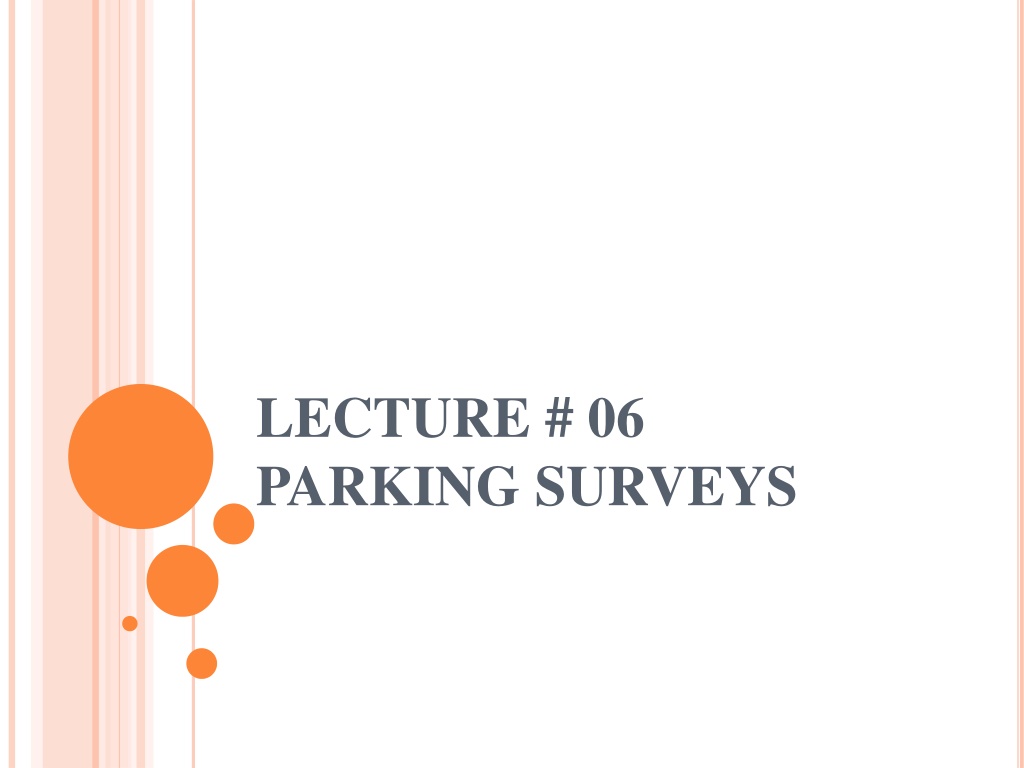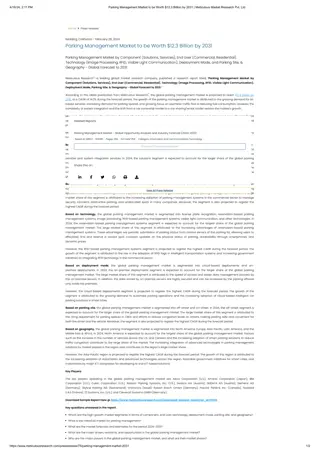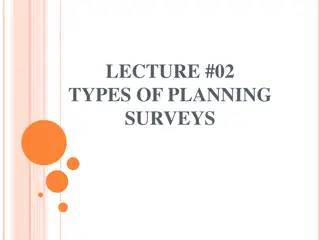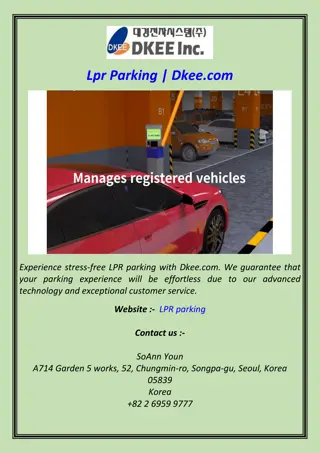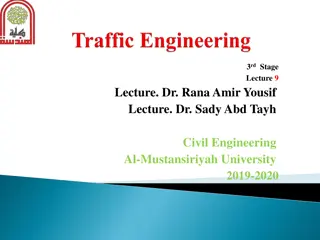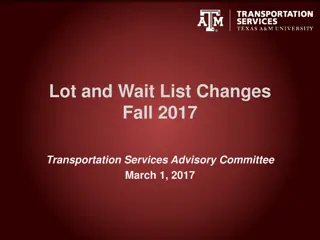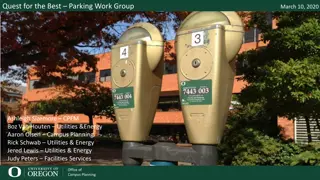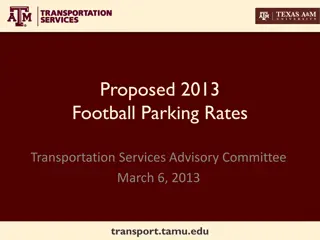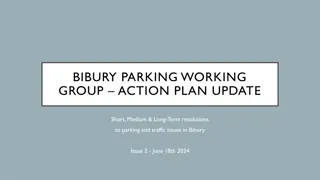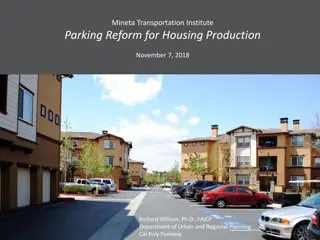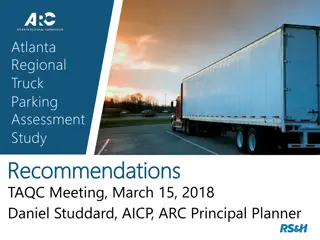Understanding Parking Surveys for Urban Planning
Parking surveys play a crucial role in urban planning and traffic management by providing data on parking space availability, usage, and demand. These surveys help in determining effective parking policies, such as pricing strategies and duration limits. Different types of surveys, including parking space inventory and usage surveys, aid in formulating comprehensive parking plans for efficient urban development. Conducting questionnaire-based surveys and analyzing parking usage are essential for assessing parking adequacy and optimizing parking facilities in urban areas.
Download Presentation

Please find below an Image/Link to download the presentation.
The content on the website is provided AS IS for your information and personal use only. It may not be sold, licensed, or shared on other websites without obtaining consent from the author. Download presentation by click this link. If you encounter any issues during the download, it is possible that the publisher has removed the file from their server.
E N D
Presentation Transcript
LECTURE # 06 PARKING SURVEYS
PARKING SURVEY Parking is one of the serious problems that confront the urban planner and the traffic engineer. Before any measure for the betterment of the parking facility, basic data pertaining to the availability of parking space, extent of its usage and parking demand are essential. For example, if it is proposed to implement a system of parking charges it will be necessary to know how much to charge and what will be the effect of the pricing policy on parking. Parking surveys are intended to supply all this kind of information.
CONT.. In order to provide proper parking system, various questions need to be answered such as What is sufficient parking and what is not? Is existence of empty spaces throughout the day a sufficient measure? If so, how many spaces should be provided? Should the parking duration be limited? Is the supply of parking equal to or greater than demand for parking?
TYPES OF PARKING SURVEYS The type of parking survey to be conducted for formulating a comprehensive parking plan for an area can vary in scope. The following are the type of parking surveys usually conducted Parking space inventory Questionnaire Type Parking Usage Survey Parking Usage Survey
PARKING SPACE INVENTORY A parking inventory is a physical count of existing parking spaces. It includes on and off street parking. For marked spaces, a numerical count is made. For unmarked spaces , a rolling ,measuring device is used to make an accurate estimate of the number of possible spaces.
QUESTIONNAIRE TYPE PARKING USAGE SURVEY This survey is carried out to know the usage of a particular parking lot from the users. For this purpose, a questionnaire is prepared which is then filled by the people who are using that particular parking lot. Each questionnaire should identify the space the vehicle occupied. This study can also be used with an origin - destination study.
PARKING USAGE SURVEY Usage is a significant measure of parking adequacy. It is based o the number of vehicles in a specific area and the length of time vehicles are parked in the area. This survey may be conducted during normal duty hours or during maximum usage hours.
SURVEY METHODOLOGY FOR PARKING USAGE SURVEY Identify the Study Area The selected parking space for the survey should be no larger than one observer can handle in 15 minutes. A 50 to 100 space parking lot, providing parking to retail area, can be chosen for one observer. The procedure is applicable to both on and off street parking with no limit to the number of parking spaces. The nature and size of the retail lot should be sufficient to demonstrate the analysis techniques. The parking lot should allow the observer to see the license plate of each vehicle and permit easy passage from one space to another. 1.
CONT.. Sketch the Lot and Determine the Best Path for Data Collection Data collection requires the observer to circulate through the lot at a regular interval, follow a predefined path, and record the license plate numbers of the vehicles occupying the space. To best accomplish this task, various routes through the lot should be examined and best one selected. It is important that the observer follow this same route each and every time data is collected. Varying from the predetermined route will jeopardize the credibility of the data. 2.
CONT.. Since parking space numbering is rare, a sketch of the designated route through the lot should be kept with the data collection sheets so that the numbered data entries can be associated with their spaces.
CONT.. Prepare Walkthrough The data collection form includes one row for each parking space and one column for each 15-minute interval. Entries in the form should have one of the three types. Data Collection Sheets and Do a trial 3. The number of the license plate for vehicles first observed in a particular space. A check for the same vehicle still in the space recorded on the previous tour. Adash if the space is empty Preparing a sufficient amount of data collection forms in advance and testing the path through the lot will ease much of the burden of the fieldwork.
CONT.. Collect the Data At the start of each period, the observer proceeds through the lot, following the prescribed route and recording the license plate number of each parked vehicle. Empty spaces should be recorded by a dash so that a full accounting of the lot is secured. On completing one round, the observer will wait until fifteen minutes are passed and then, proceed with the next round of data collection. This is repeated until the full study time expires. 4.
CONT.. Check The Data Before Leaving The Field As always, data should be reviewed prior to leaving the field and any discrepancies resolved. 5.
CONT.. Summarize the Data and Draw Conclusions The investigator should summarize the number of vehicles that used the space during the observation period as well as the total time each spaced was occupied. Note that the time a vehicle occupied a space is inferred from the observation interval, but such inference can be invalid. It is allowed that error above and below the actual values offset each other so that quality results are realized . 6.
CONT.. The investigator should be certain that conclusions are based on the collected data and that the limitations of the methodology are clearly presented. Question that should be addressed include: Is parking area fully utilized? Does the parking demand appear to be satisfied? Would relocation of the access better utilize the parking area? Is there one time period that exhibits a much higher demand than others? Why? Except for construction of new spaces, what can be done to improve parking at this location?
